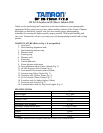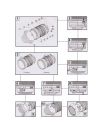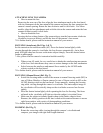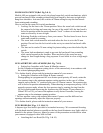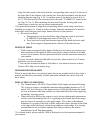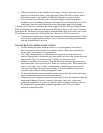Align the index mark on the hood with the corresponding index mark (O or the top of
the index line of the distance scale) on the lens. Press the hood lightly onto the hood
attaching bayonet ring (Fig. 9, No. 1) and then rotate it clockwise to secure (Fig. 9,
No. 2). The lens hood will be securely held as the mark “TAMRON O” comes to the
top (Fig. 10, No. 3). When attaching the lens hood, hold the focusing and zoom
control rings so that they are not rotated unintentionally.
* Pay particular attention to align the hood attaching indices when using zoom lenses
including wise-angle (i.e. 35mm or wider) settings. Improper attachment of a hood for
wide-angle zoom lens may cause large shadowed areas in your pictures.
• Stowing Lens Hood
a. Detach and reverse lens hood then, align alignment mark of lens hood
(TAMRON O) with alignment mark of lens. (Fig. 11,a).
b. Press lens hood evenly onto bayonet ring and turn hood clockwise until
stop. When stopped, alignment mark of hood will be placed at top.
DEPTH OF FIELD
• With a camera equipped with a depth-of-field-preview button or a aperture-stop-
down mechanism, the depth-of-field can be directly observed on the viewfinder
screen of your camera. For the operational details, read the instruction manual of
your camera.
* In case you need a depth-of-field table of your lens, please ask for it at a Tamron
distributor or a service station.
* You can also download a depth-of-field table of your interest from our website.
Tamron URL: http://www.tamron.co.jp
INFRARED PHOTOGRAPHY
Please be aware that there is no infrared index line on any models listed on this owner’s
manual, and therefore, practically no black-and-white infrared film can be used with
these lenses.
PRECAUTIONS IN SHOOTING
• The Tamron lenses, AP AF28-75mm (Model A09) employ an internal focusing
(IF) system to achieve a remarkable minimum photographing distances of 0.33
meter (1.08 feet). Because of the characteristics of this optical design, the angles
of view at distances other than infinity are wider than that of the lenses applying
an ordinary focusing system.
• When the built-in flash on the camera is used, adverse photographic phenomena
such as corner illumination fall-off or vignetting at the bottom part of the image
may be observed, especially in wide-angle ranges. This is due to the inherent
limitation of coverage of the built-in flash, and/or the relative position of the flash
to the edge of the lens barrel, which causes shadows on the image. It is strongly
recommended to use a suitable separate flash unit provided by the camera
manufacturer for all flash photography.
* For further details, please read the “built-in flash article on the instruction manual of
your camera.



